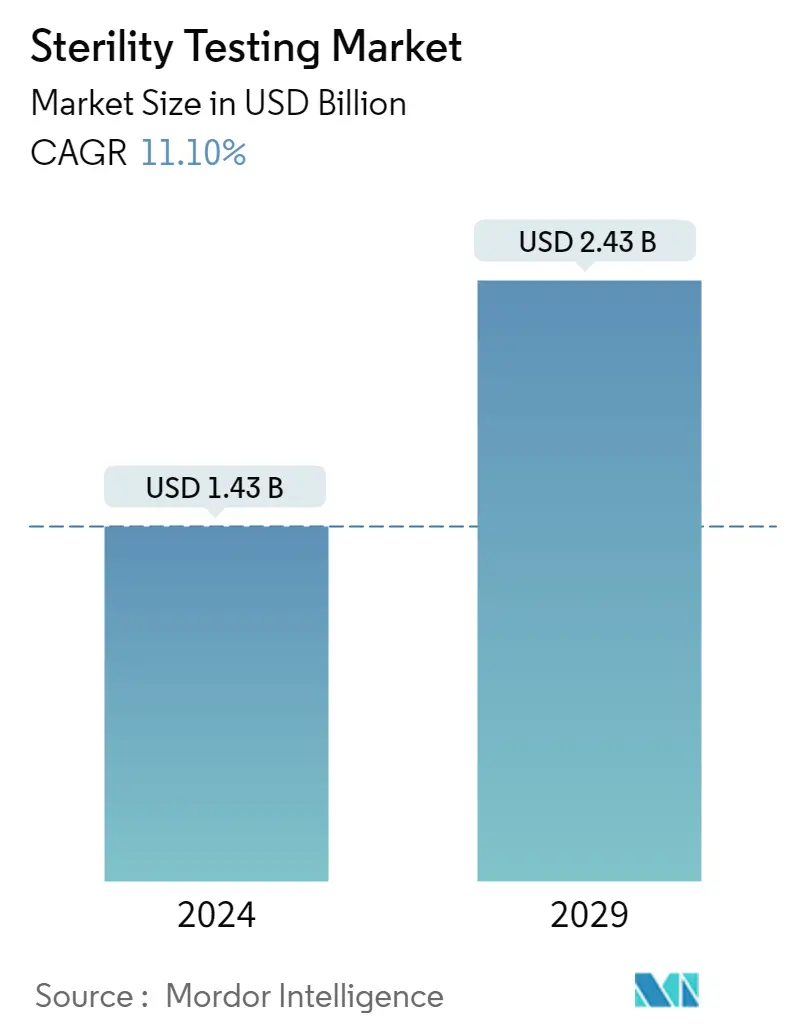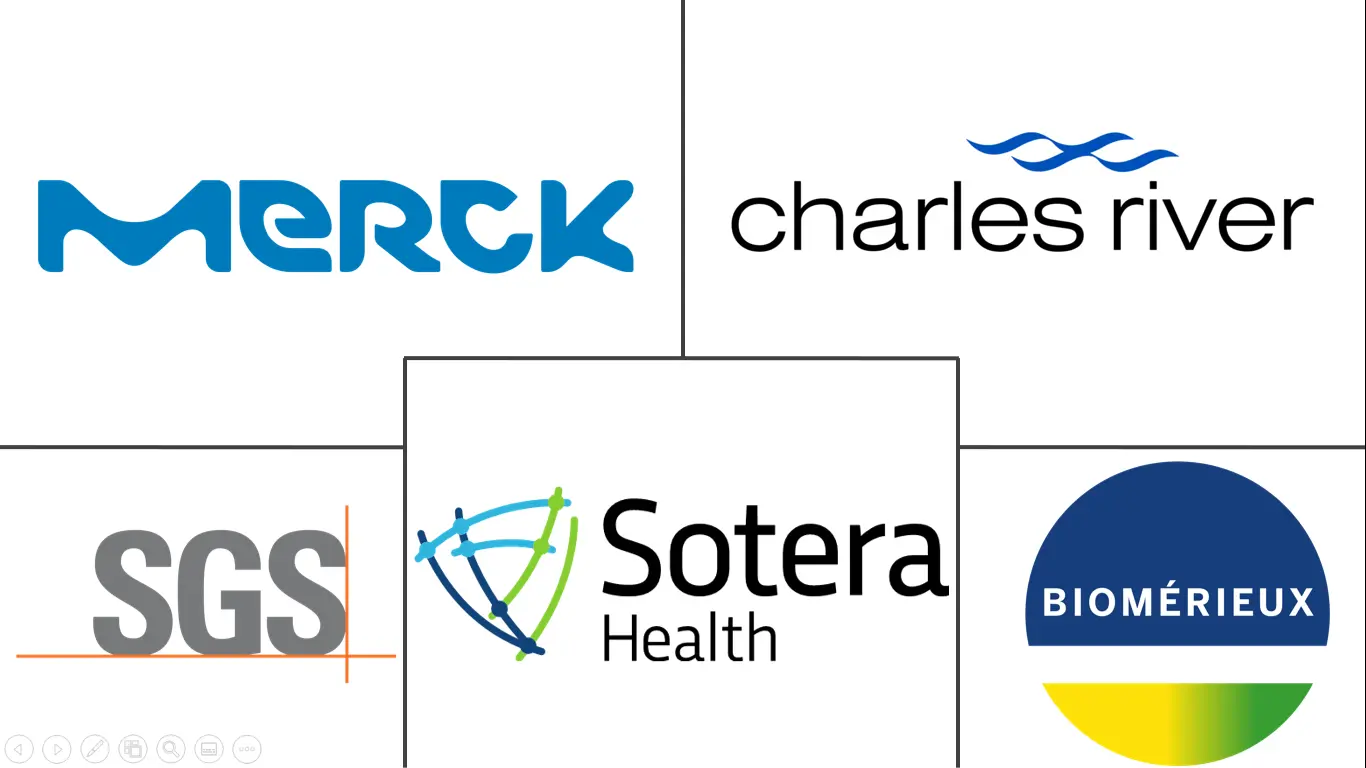Market Size of Sterility Testing Industry

| Study Period | 2019 - 2029 |
| Market Size (2024) | USD 1.43 Billion |
| Market Size (2029) | USD 2.43 Billion |
| CAGR (2024 - 2029) | 11.10 % |
| Fastest Growing Market | Asia Pacific |
| Largest Market | North America |
| Market Concentration | Medium |
Major Players
*Disclaimer: Major Players sorted in no particular order |
Sterility Testing Market Analysis
The Sterility Testing Market size is estimated at USD 1.43 billion in 2024, and is expected to reach USD 2.43 billion by 2029, growing at a CAGR of 11.10% during the forecast period (2024-2029).
The COVID-19 pandemic impacted the growth of the sterility testing market. Sterility testing was a key tool for most pharmaceutical and biotechnological companies that started focusing on their research and development for the identification of leads that can diagnose and treat the SARS-CoV-2 infection. The increase in COVID-19 cases drove the major companies and research institutions to look outside of conventional medicine or medicines, which resulted in significant investment in research and development efforts by both private and public entities worldwide. These activities have significantly boosted the sterility testing market. Moreover, the severity and high infection rate of infections and the growing number of drugs and vaccines led to high demand for sterility testing in the pharmaceutical and biopharmaceutical production industry. This has increased the demand for strict sterility testing of the products. With the rising adoption and demand for sterility testing, the studied market is expected to regain its full potential in the next two to three years.
Factors such as the increasing research and development in life sciences, rising number of drug launches, and rise in demand for sterilized products are boosting the market growth. In addition, the rising demand for sterilized products globally and a few potential safety issues connected to the products, which typically result from manufacturing processes and complex biological and structural characteristics of the products, are anticipated to drive the market during the forecast period.
The rising burden of chronic and infectious diseases among the population raises the demand for strict sterility testing of drugs and medical devices to ensure the safety of the products and devices. This is anticipated to fuel the market growth over the forecast period. For instance, according to the British Heart Foundation England Factsheet, published in January 2022, about 6.4 million people were living with cardiovascular diseases in England in 2021. In addition, as per the same source, around 7.4 million people were living with heart and circulatory diseases in the United Kingdom in 2021. Also, as per the data published by WHO, in October 2022, the incidence of tuberculosis was estimated to be around 10.6 million people globally in 2021, of which 1.2 million were children.
Additionally, the increasing number of chronic diseases further increases the demand for effective drugs, which is also expected to propel the need for sterility tests of the drugs before launching them into the market, thereby fuelling the market growth. For instance, in September 2022, the Government of India launched a vaccine against cervical cancer Quadrivalent Human Papillomavirus vaccine (qHPV), which has been developed by the Serum Institute of India (SII) and the Department of Biotechnology (DBT). Also, in September 2022, Bayer launched vericiguat in India to reduce the risk of cardiovascular deaths and repeated hospitalizations.
Furthermore, the increasing research and development in the field of life sciences, coupled with huge public and private funding in the sector, is also contributing to the market growth. For instance, as per the Union Budget for the year 2021-2022, the Indian Ministry of Science and Technology allocated a budget of INR 35 billion, a 25% hike from the 2020-21 budget, for the Department of Biotechnology (DBT) of India, mainly for biotechnology research and development and industrial and entrepreneurship development in the country which will boost the studied market.
Moreover, the growing company activities in adopting various business strategies such as expansion, collaboration, and others are also contributing to the market growth. For instance, in September 2021, Nelson Labs and Sterigenics Germany GmbH, global leaders in comprehensive laboratory testing and sterilization services, announced the opening of a newly expanded center of excellence for microbiological laboratory testing as well as increased sterilization capacity in their Wiesbaden, Germany, facilities.
Therefore, owing to the aforementioned factors, the studied market is expected to grow over the forecast period. However, the stringent regulatory framework is expected to hinder the growth of the sterility testing market over the forecast period.
Sterility Testing Industry Segmentation
As per the scope of the report, sterility testing is performed to reveal the presence of microorganisms such as bacteria, fungi, and yeast in pharmaceutical products or devices before the release and patent administration. The sterility testing market is segmented by product type (instruments, kits and reagents, and services), test type (membrane filtration, direct inoculation, and other sterility tests), application (pharmaceutical and biological manufacturing, medical devices manufacturing, and other applications), and geography (North America, Europe, Asia-Pacific, Middle-East and Africa, and South America). The market report also covers the estimated market sizes and trends for 17 different countries across the major regions globally. The report offers the value (in USD million) for the above segments.
| By Product Type | |
| Instruments | |
| Kits and Reagents | |
| Services |
| By Test Type | |
| Membrane Filtration | |
| Direct Inoculation | |
| Other Sterility Tests |
| By Application | |
| Pharmaceutical and Biological Manufacturing | |
| Medical Device Manufacturing | |
| Other Applications |
| Geography | ||||||||
| ||||||||
| ||||||||
| ||||||||
| ||||||||
|
Sterility Testing Market Size Summary
The sterility testing market is poised for significant growth, driven by the increasing demand for sterility testing in pharmaceutical and biopharmaceutical production. The market's expansion is fueled by the rising research and development activities in life sciences, the growing number of drug launches, and the heightened demand for sterilized products globally. The COVID-19 pandemic has further accelerated market growth, as it prompted substantial investments in research and development by both private and public entities, focusing on the development of vaccines and treatments. This surge in activity has underscored the critical importance of sterility testing to ensure the safety and efficacy of pharmaceutical and medical products. The market is expected to regain its full potential in the coming years, supported by the ongoing advancements in biotechnology and the increasing prevalence of chronic and infectious diseases, which necessitate rigorous sterility testing protocols.
North America is anticipated to hold a significant share of the sterility testing market, with the United States leading due to its robust pharmaceutical and biopharmaceutical industries, substantial government and private funding for research and development, and favorable regulatory environment. The region's market growth is further bolstered by the rising number of drug launches and clinical trials aimed at addressing various health conditions. The competitive landscape of the sterility testing market is moderately populated with major players such as BioMérieux, Charles River Laboratories, and Merck KGaA, among others. These companies are actively expanding their capabilities and offerings to meet the growing demand for sterility testing services. Despite the promising growth prospects, the market faces challenges from stringent regulatory frameworks that could potentially hinder its expansion.
Sterility Testing Market Size - Table of Contents
-
1. MARKET DYNAMICS
-
1.1 Market Overview
-
1.2 Market Drivers
-
1.2.1 Increasing Research and Development in Life Sciences
-
1.2.2 Increasing Number of Drug Launches
-
1.2.3 Rise in Demand for Sterilized Products
-
-
1.3 Market Restraints
-
1.3.1 Stringent Regulatory Framework
-
-
1.4 Porter's Five Forces Analysis
-
1.4.1 Threat of New Entrants
-
1.4.2 Bargaining Power of Buyers/Consumers
-
1.4.3 Bargaining Power of Suppliers
-
1.4.4 Threat of Substitute Products
-
1.4.5 Intensity of Competitive Rivalry
-
-
-
2. MARKET SEGMENTATION (Market Size by Value - USD million)
-
2.1 By Product Type
-
2.1.1 Instruments
-
2.1.2 Kits and Reagents
-
2.1.3 Services
-
-
2.2 By Test Type
-
2.2.1 Membrane Filtration
-
2.2.2 Direct Inoculation
-
2.2.3 Other Sterility Tests
-
-
2.3 By Application
-
2.3.1 Pharmaceutical and Biological Manufacturing
-
2.3.2 Medical Device Manufacturing
-
2.3.3 Other Applications
-
-
2.4 Geography
-
2.4.1 North America
-
2.4.1.1 United States
-
2.4.1.2 Canada
-
2.4.1.3 Mexico
-
-
2.4.2 Europe
-
2.4.2.1 Germany
-
2.4.2.2 United Kingdom
-
2.4.2.3 France
-
2.4.2.4 Italy
-
2.4.2.5 Spain
-
2.4.2.6 Rest of Europe
-
-
2.4.3 Asia-Pacific
-
2.4.3.1 China
-
2.4.3.2 Japan
-
2.4.3.3 India
-
2.4.3.4 Australia
-
2.4.3.5 South Korea
-
2.4.3.6 Rest of Asia-Pacific
-
-
2.4.4 Middle-East and Africa
-
2.4.4.1 GCC
-
2.4.4.2 South Africa
-
2.4.4.3 Rest of Middle-East and Africa
-
-
2.4.5 South America
-
2.4.5.1 Brazil
-
2.4.5.2 Argentina
-
2.4.5.3 Rest of South America
-
-
-
Sterility Testing Market Size FAQs
How big is the Sterility Testing Market?
The Sterility Testing Market size is expected to reach USD 1.43 billion in 2024 and grow at a CAGR of 11.10% to reach USD 2.43 billion by 2029.
What is the current Sterility Testing Market size?
In 2024, the Sterility Testing Market size is expected to reach USD 1.43 billion.

